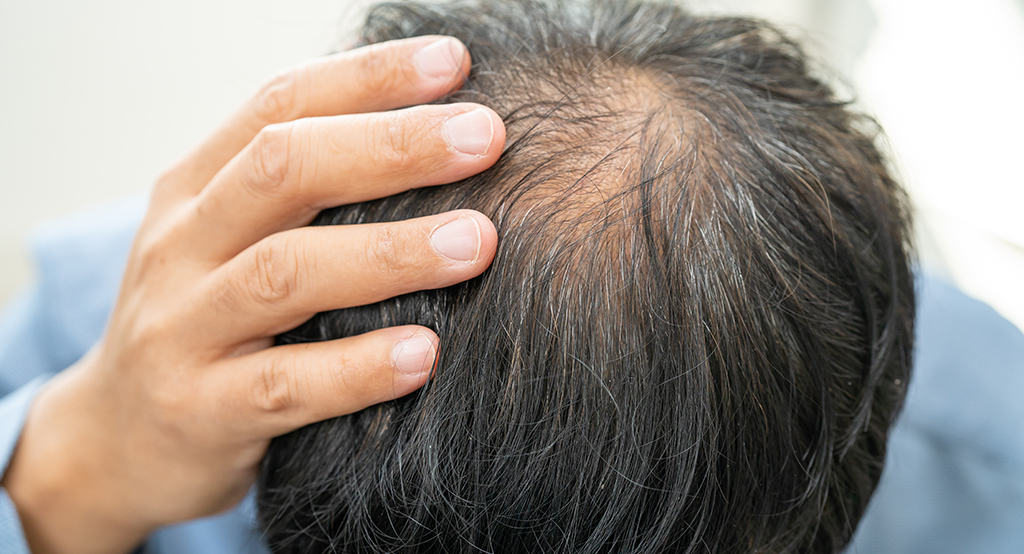If you’ve noticed your hairline thinning, receding or becoming patchy, you’re not imagining it. Hairline alopecia is incredibly common, yet it’s also one of the most misunderstood forms of hair loss. Many people are told it’s “normal,” “just ageing,” or “probably stress,” but the truth is that hairline thinning has very specific causes and most of them can be treated when they’re caught early.
The hairline is one of the most delicate areas on your scalp. It’s highly sensitive to styling tension, hormonal changes, inflammation, trauma, and autoimmune conditions. Because of this, it’s often the first place where thinning shows up. If you’re seeing gaps at the temples, your ponytail looks different or you’re noticing a creeping recession, you’re in the right place.
In this guide, I want to help you understand why hairline alopecia happens, how dermatologists identify the cause, and what treatments actually help. The earlier you take action, the easier it is to restore density and protect your frontal hairline long term.
Why Hairline Alopecia Happens
Hairline thinning can develop gradually or suddenly. Some people notice a widening temple area over months, while others experience rapid loss around the frontal scalp due to hormonal shifts, immune reactions or styling habits.
The key is identifying which cause applies to you because the wrong treatment can actually make things worse.
Main Causes of Alopecia Around the Hairline

Here are the most common reasons your hairline may be thinning.
1. Traction Alopecia (Hairstyle-Related Loss)
Traction alopecia is one of the leading causes of hairline thinning, especially in women.
It happens when repeated tension from hairstyles pulls on the hair follicles.
Common culprits include:
- Tight ponytails
- Slick-back hairstyles
- Braids or cornrows
- Weaves
- Hair extensions
- Buns worn in the same spot
- Tight headscarves
Initially, the damage is temporary but if the tension continues, follicles weaken and stop producing hair altogether.
Key signs:
- Thinning around the temples
- Small broken hairs
- A creeping “V-shaped” recession
- Redness or soreness
- Pustules or itching
The good news? If you catch traction alopecia early, you can often reverse it.
2. Hormonal Thinning (Especially Around Perimenopause)
Hormonal changes play a big role in frontal hairline thinning.
Oestrogen helps protect hair, and as levels drop during perimenopause and menopause, the hairline can become thinner and more fragile.
Other hormonal triggers include:
- Pregnancy
- Postpartum shedding
- Stopping or starting contraception
- Thyroid imbalances
- PCOS
Hairline thinning from hormones often appears as gradual recession rather than patchy loss.
3. Frontal Fibrosing Alopecia (FFA)
FFA is a type of scarring alopecia that affects the frontal hairline, eyebrows, and sometimes the temples.
It’s one of the fastest-growing diagnoses in women over 40, but it can appear earlier too.
Key signs:
- A slowly receding, straight “band-like” hairline
- Loss of eyebrow density
- Smooth, pale skin where hair once grew
- Little to no regrowth
- Itching or burning sensations
FFA needs early medical intervention because the scarring process can become permanent.
4. Alopecia Areata Along the Hairline
Alopecia areata can appear as patchy loss anywhere on the scalp including the frontal hairline.
Signs include:
- Round or oval bald patches
- Sudden loss
- Tingling or itching
- Exclamation-mark hairs (short broken hairs)
This type is caused by your immune system attacking the hair follicle. With the right treatment, regrowth is often possible.
5. Telogen Effluvium Triggering Temple Loss
Stress, illness, infection or nutritional deficiencies can push more hairs into the “shedding phase,” leading to diffuse thinning including around the hairline.
Common triggers include:
- COVID-19
- Fever or illness
- Surgery
- Crash dieting
- Iron deficiency
- Medication changes
Although telogen effluvium is temporary, it can make your hairline look thinner quickly.
6. Styling Damage & Heat Trauma
Chronic use of:
- Straighteners
- Curling wands
- Hot combs
- Harsh chemical relaxers
- Frequent colouring
can break and weaken hair along the front.
Hairline hair is naturally finer than the rest of your scalp, so heat damage shows up here first.
7. Nutritional Deficiencies
Your hairline relies heavily on proper nutrition.
Deficiencies linked to hairline thinning include:
- Iron
- Vitamin D
- B12
- Zinc
- Protein
- Omega-3
If your diet is inconsistent or you’re feeling tired and run-down, nutritional testing can make a huge difference.
8. Seborrhoeic Dermatitis, Folliculitis or Scalp Inflammation
Inflammation disrupts your hair growth cycle.
Conditions affecting the frontal scalp include:
- Seborrhoeic dermatitis
- Psoriasis
- Fungal infections
- Folliculitis
- Contact dermatitis from hair products
Inflamed scalp = weaker follicles.
How Dermatologists Diagnose Hairline Alopecia

Because the causes are so varied, diagnosis is incredibly important. Treating the wrong type of alopecia can cause more loss especially with conditions like FFA or traction alopecia.
Here’s what a dermatologist typically checks:
1. Detailed Scalp Examination
They’ll look at:
- The pattern of thinning
- Any redness or scaling
- Signs of inflammation
- Follicle openings (or lack of them)
- Breakage versus true loss
2. Trichoscopy (Scalp Microscopy)
This is one of the most useful tools. It helps identify:
- Scarring
- Miniaturisation
- Broken hairs
- Exclamation-mark hairs
- Follicular plugging
This tells your dermatologist which type of alopecia you’re dealing with.
3. Blood Tests
You may be tested for:
- Iron
- Ferritin
- Vitamin D
- Thyroid levels
- Hormonal markers
These deficiencies are common in women with hairline thinning.
4. Medical & Styling History
Your haircare habits help reveal whether:
- Traction
- Heat
- Chemical exposure
- Recent stress
- Illness
- Medication
are contributing.
5. Biopsy (Only in Rare Cases)
If scarring alopecia (like FFA) is suspected, a biopsy may be recommended.
Effective Treatment Options for Hairline Alopecia
The right treatment depends entirely on identifying the cause. Here’s what dermatologists use to restore density and slow progression.
1. Treatments for Traction Alopecia
If traction is the cause, the first step is removing tension immediately.
Your plan may include:
- Stopping tight styles
- Avoiding extensions or braids
- Wearing your hair down more often
- Reducing heat and chemicals
- Switching to silk or satin pillowcases
Dermatologists may also recommend:
- Minoxidil
- PRP
- Anti-inflammatory treatments if the scalp is irritated
When caught early, traction alopecia responds very well.
2. Treatments for Hormonal Hairline Thinning
Your hairline can respond beautifully to hormonal support.
Options include:
- Minoxidil
- Spironolactone
- Oral contraceptive adjustments
- Thyroid treatment
- PRP
- Low-level laser therapy
In perimenopause, a combined approach usually works best.
3. Treatments for Frontal Fibrosing Alopecia (FFA)
FFA needs urgent and early treatment.
Dermatologists often prescribe:
- Topical steroids
- Oral anti-inflammatory medications
- Hydroxychloroquine
- Dutasteride or finasteride (post-menopause)
- PRP to improve density around stable areas
The goal is to stop progression and protect existing follicles.
4. Treatments for Alopecia Areata Along the Hairline
Alopecia areata can respond extremely well to medical treatment.
Options include:
- Steroid injections
- Topical steroid therapy
- Calcineurin inhibitors
- JAK inhibitor creams or tablets
- PRP
- Light therapy
Early treatment increases the chances of regrowth.
5. Treatments for Telogen Effluvium Affecting the Hairline
This type corrects itself once the trigger is treated.
Supportive treatment includes:
- Iron supplementation
- Vitamin D correction
- Stress management
- Gentle topicals
- PRP for density boost
- Minoxidil to speed regrowth
Expect improvement over 3–6 months.
6. Treatments for Heat or Chemical Damage
You can rebuild your hairline by:
- Avoiding heat for several months
- Switching to nourishing, gentle products
- Treating inflammation
- Using minoxidil
- Considering PRP
Hairline hair takes time to recover, but the change can be dramatic when you remove the damage.
7. Treatments for Scalp Inflammation
If inflammation is disrupting your hairline, your dermatologist may recommend:
- Antifungal shampoo
- Steroid lotions
- Salicylic acid
- Coal tar
- Keratolytic treatments
- Anti-inflammatory scalp care routines
Treating the scalp environment is essential for regrowth.
Lifestyle and At-Home Changes to Support Hairline Recovery
There’s a lot you can do at home to reduce future thinning.
1. Switch to loose hairstyles
Your hairline needs space to recover.
2. Use gentle, sulphate-free shampoos
Avoid harsh stripping products.
3. Avoid daily heat styling
This significantly reduces breakage.
4. Improve sleep and reduce cortisol levels
Stress directly affects your hairline.
5. Increase protein and iron-rich foods
Hair is made of protein nutrition matters.
6. Massage your hairline daily
This boosts microcirculation.
7. Choose lightweight, non-greasy products
Heavy oils can clog follicles.
How Long Does It Take for the Hairline to Recover?
Timeline depends on the cause.
Traction alopecia:
3–9 months for early cases, longer for chronic damage
Hormonal thinning:
4–12 months with treatment
Alopecia areata:
Regrowth may begin in 6–12 weeks
FFA:
Goal is stabilisation, not full reversal
Telogen effluvium:
3–6 months to recover
Consistency is key the hairline takes time.
FAQs:
1. What exactly is hairline alopecia and how is it different from other types of hair loss?
Hairline alopecia refers specifically to thinning or loss of hair along the frontal scalp and temples. Unlike diffuse hair thinning that affects the entire scalp, hairline alopecia is concentrated around the front, which makes it more noticeable in hairstyles or ponytails. It can result from tension, hormonal shifts, autoimmune conditions, or scarring, so understanding the underlying cause is crucial. While other forms of alopecia may appear suddenly or in patches, hairline thinning often develops gradually and can be subtle at first.
2. Can hairline thinning be reversed, or is it always permanent?
Whether hairline thinning can be reversed depends on the cause and how early it’s addressed. Tension-related thinning, hormonal fluctuations, and telogen effluvium can often be improved with treatment and lifestyle changes, leading to regrowth. Autoimmune or scarring conditions, like frontal fibrosing alopecia, may stabilise with treatment but regrowth can be limited in affected areas. Early diagnosis and consistent management greatly improve the chances of restoring density.
3. How does traction from hairstyles contribute to hairline thinning?
Repeated tension from tight hairstyles, such as braids, ponytails, or extensions, gradually damages hair follicles. Over time, this stress can cause follicles to weaken and eventually stop producing hair. Early signs include thinning at the temples, small broken hairs, and mild soreness. If the tension continues, permanent loss can occur. Adjusting hairstyles and reducing strain on the hairline often allows the follicles to recover, especially when combined with supportive dermatological treatments.
4. Are hormonal changes a common trigger for hairline alopecia?
Yes, hormonal shifts play a significant role in hairline thinning, particularly around perimenopause and menopause when oestrogen levels drop. Pregnancy, postpartum changes, thyroid imbalances, contraceptive adjustments, and PCOS can also trigger thinning. Hormonal hair loss often appears as a gradual recession along the frontal scalp rather than patchy loss. Addressing hormone levels through medical guidance, alongside topical or systemic treatments, can significantly improve density and slow progression.
5. What is frontal fibrosing alopecia and why is it concerning?
Frontal fibrosing alopecia (FFA) is a type of scarring alopecia that affects the frontal hairline, temples, and sometimes eyebrows. It’s characterised by a slowly receding, straight hairline with smooth, pale skin and little to no regrowth. FFA is concerning because the scarring process can permanently destroy follicles if untreated. Early medical intervention is essential to stabilise the condition, protect remaining hair, and manage inflammation with therapies like topical steroids, oral medications, or PRP in stable areas.
6. How does alopecia areata affect the hairline?
Alopecia areata is an autoimmune condition in which the immune system attacks hair follicles, leading to sudden, patchy hair loss along the frontal scalp or temples. It may appear as round or oval bald spots and is sometimes accompanied by tingling, itching, or exclamation-mark hairs. With timely treatment, such as steroid injections, topical immunomodulators, or PRP therapy, hair often regrows, although recurrence is possible. Early intervention increases the likelihood of restoring the hairline successfully.
7. Can stress or illness cause hairline thinning?
Yes, stress and illness can trigger a form of temporary hair loss called telogen effluvium, where more hairs enter the shedding phase. The shedding may not appear immediately and can show up several weeks or months after the stressful event. Hairline thinning from telogen effluvium is usually diffuse but may affect temples more noticeably. Once the trigger is managed, hair typically regrows over three to six months, especially when combined with supportive treatments like minoxidil, nutritional correction, and gentle haircare.
8. How do dermatologists diagnose the cause of hairline alopecia?
Diagnosis involves a detailed scalp examination, trichoscopy (scalp microscopy), blood tests for nutrient and hormone levels, and reviewing styling habits or recent medical history. In some cases, a biopsy is needed, particularly for scarring alopecias like FFA. These evaluations help dermatologists differentiate between tension-related, hormonal, autoimmune, and inflammatory causes, ensuring the right treatment plan is implemented. Accurate diagnosis is critical because treating the wrong type of alopecia can worsen hair loss.
9. What treatment options are available for hairline alopecia?
Treatment depends entirely on the underlying cause. Traction alopecia responds well to removing tension, adjusting hairstyles, and using supportive treatments like minoxidil or PRP. Hormonal hairline thinning may improve with topical therapies, oral medications, or hormone regulation. Autoimmune conditions and scarring alopecias require medical intervention to stabilise hair loss, while telogen effluvium typically recovers once the trigger is addressed. Combining medical treatments with scalp care, nutrition optimisation, and lifestyle adjustments maximises the chances of restoring the hairline.
10. How long does it take to see results from hairline alopecia treatment?
Hair grows slowly, so results vary by cause and treatment. Traction alopecia may improve in three to nine months if addressed early, while hormonal thinning can take four to twelve months for visible regrowth. Alopecia areata may show improvement within six to twelve weeks, whereas telogen effluvium usually resolves in three to six months. Scarring alopecias aim for stabilisation rather than full regrowth. Consistency, patience, and following a dermatologist’s plan are essential for achieving and maintaining hairline recovery.
Final Thought: Taking Action Against Hairline Alopecia
Hairline thinning can feel worrying, but the earlier you identify the cause, the better your chances of restoring density and protecting your hairline long term. Even subtle changes at the temples or along the frontal hairline shouldn’t be ignored, as early intervention often leads to the best results. Understanding the underlying cause whether it’s hormonal, stress-related, or due to styling habits can make a big difference in choosing the right approach. From adjusting hairstyles and managing stress to targeted medical treatments, there are effective ways to slow, stop, or even reverse hairline alopecia. If you’re thinking about alopecia treatment in London, you can get in touch with us at the London Dermatology Centre to schedule a consultation with one of our expert specialists.
References:
1. Sharquie, K.E., 2021. Traction Alopecia: Clinical and Cultural Patterns. Journal of [Dermatology]. https://pubmed.ncbi.nlm.nih.gov/34759419/
2. Larrondo, J., & McMichael, A.J., 2023. Traction Alopecia. Patient Page. https://pubmed.ncbi.nlm.nih.gov/37133879/
3. Abdallah, S., 2025. Prevalence and Associated Factors of Traction Alopecia in Women in North Sudan. Medicina, 61(2), 195. https://www.mdpi.com/1648-9144/61/2/195
4. Krzesłowska, W.J., Cisoń, H., Pakiet, A., Nowicka, D. & Szepietowski, J.C., 2024. The Frontal Fibrosing Alopecia Treatment Dilemma. Journal of Clinical Medicine, 13(7), 2137. https://www.mdpi.com/2077-0383/13/7/2137
5. Ngwanya, R.M., Khumalo, N.P. & Mwachaka, P.M., 2019. Reliability of Histopathology for the Early Recognition of Traction Alopecia. International Journal of Dermatopathology, https://pmc.ncbi.nlm.nih.gov/articles/PMC6827454/
